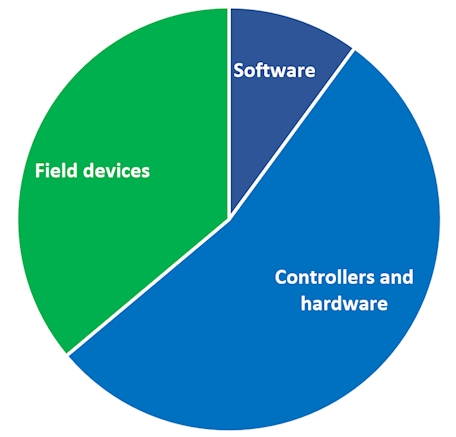Building Automation and Controls in light commercial buildings
New BSRIA Worldwide Market Intelligence (WMI) study covering Germany, Italy, France, and the UK estimates the market for building automation controls in light commercial buildings at EUR 275 million in 2022.
The building automation software, controllers, hardware, and field devices installed in light commercial buildings account for a significant share of overall BACS product sales in the four major European markets estimated at EUR 1.1 billion.
Most BACS products installed in light commercial buildings are found in offices, with 40-50% share, followed by hotels, education, health, retail and mixed-use buildings with some variation in each country.

|
| Source: BSRIA Worldwide Market Intelligence |
It is also worth noting that building automation controls products sold to the light commercial building segment are expected to grow at a higher rate than the overall BACS market, particularly in 2024 and 2025 with 11% and 13% respectively. Most of the European economies showed good economic growth in 2021, but Russia's invasion of Ukraine is increasingly impacting economies in 2022.
On the positive side, the European Energy Performance of Buildings Directive (EPBD) drives the adoption of BACS to optimise energy use through better automation, control, and monitoring. In December 2021, the European Commission proposed a new directive that states that non-residential buildings will have to be renovated and improved to at least energy performance grade F by 2027 and grade E by 2030 as part of European Union’s net zero-emission strategy.
Over half the sales are accounted for by controllers and hardware, followed by field devices, and then software.

|
| Source: BSRIA Worldwide Market Intelligence |
BSRIA WMI's BACS in Light Commercial Buildings study includes products falling within the following definitions:
- Professionally installed systems.
- A minimum of two or more interconnected systems (HVAC, lighting, blinds, occupancy sensors, security etc.).
- Open systems/platforms with protocols such as KNX, BACnet and LON.
- Wired controllers/systems with the capability to integrate wireless devices and cloud connection.
- Most systems installed in buildings with floor space below 25,000 sq. ft or 2,323 m2.
The value is in Manufacturer Selling Prices (MSP) covering products (not labour). The study does not cover plug & play products installed in the residential market, nor does it cover systems connected to big plant equipment.
The study is part of BSRIA WMI’s BACS and Smart building portfolio, which includes world studies on building automation and publications on field devices (valves, actuators and sensors). BSRIA WMI is a leading provider of studies covering building services such as structured cabling, building controls, air conditioning, ventilation, refrigeration & refrigerants, and heat pumps.
This article originally appeared on the BSRIA News and Blog site under the same title dated August 2022.
--BSRIA
[edit] Related articles on Buildings Design
- BACS building automation controls - the information revolution.
- BS EN 15232 Energy performance of buildings: impact of building automation, controls and building management.
- BSRIA articles.
- Building management systems BMS.
- Intelligent building management systems IBMS.
- Use class designation for land and buildings.
Featured articles and news
Twas the site before Christmas...
A rhyme for the industry and a thankyou to our supporters.
Plumbing and heating systems in schools
New apprentice pay rates coming into effect in the new year
Addressing the impact of recent national minimum wage changes.
EBSSA support for the new industry competence structure
The Engineering and Building Services Skills Authority, in working group 2.
Notes from BSRIA Sustainable Futures briefing
From carbon down to the all important customer: Redefining Retrofit for Net Zero Living.
Principal Designer: A New Opportunity for Architects
ACA launches a Principal Designer Register for architects.
A new government plan for housing and nature recovery
Exploring a new housing and infrastructure nature recovery framework.
Leveraging technology to enhance prospects for students
A case study on the significance of the Autodesk Revit certification.
Fundamental Review of Building Regulations Guidance
Announced during commons debate on the Grenfell Inquiry Phase 2 report.
CIAT responds to the updated National Planning Policy Framework
With key changes in the revised NPPF outlined.
Councils and communities highlighted for delivery of common-sense housing in planning overhaul
As government follows up with mandatory housing targets.
CIOB photographic competition final images revealed
Art of Building produces stunning images for another year.
HSE prosecutes company for putting workers at risk
Roofing company fined and its director sentenced.
Strategic restructure to transform industry competence
EBSSA becomes part of a new industry competence structure.
Major overhaul of planning committees proposed by government
Planning decisions set to be fast-tracked to tackle the housing crisis.
Industry Competence Steering Group restructure
ICSG transitions to the Industry Competence Committee (ICC) under the Building Safety Regulator (BSR).
Principal Contractor Competency Certification Scheme
CIOB PCCCS competence framework for Principal Contractors.
The CIAT Principal Designer register
Issues explained via a series of FAQs.

























